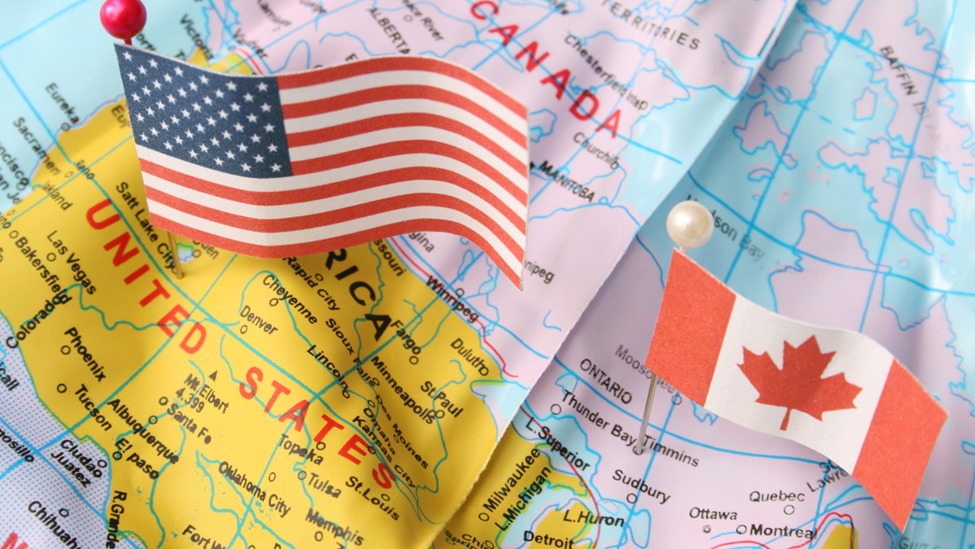Navigating Cross-Border Taxes in 2025: What Canadian and U.S. Dual Citizens Need to Know

Introduction
For individuals who hold both Canadian and U.S. citizenship, living across borders can be both exciting and challenging. On one hand, you enjoy the unique blend of cultural experiences and professional opportunities that come from straddling two countries. On the other hand, you face a complex set of tax obligations that are shaped by evolving regulations in both Canada and the United States. The year 2025 has introduced a series of legislative changes that significantly impact how dual tax residency is defined, understood, and reported. These changes carry important consequences for your tax liabilities, filing deadlines, allowable deductions, and even estate planning.
In an era where global mobility is on the rise, many individuals find themselves living part of the year in one country and part of the year in another. Some people grew up with parents from both sides of the border, while others became dual citizens through marriage or naturalization. No matter how you arrived at dual residency Canada USA, the tax codes in both countries demand that you stay informed of each new provision that could potentially alter your financial strategy. Neglecting to remain compliant can result in steep penalties and legal complications, all of which can disrupt your personal and professional life.
One of the biggest hurdles is understanding how the Canada Revenue Agency (CRA) and the Internal Revenue Service (IRS) collaborate—and sometimes differ—in their definitions of residency, taxable income, and reporting requirements. These agencies also maintain a variety of international agreements, the most notable of which is the U.S.-Canada Tax Treaty. Although such treaties aim to prevent double taxation, the practical application often becomes complicated, especially if your personal or business circumstances are unique.
This blog will delve deep into the specifics of the 2025 regulatory landscape, highlighting what dual citizens must keep top of mind when filing taxes in both jurisdictions. From defining dual tax residency to outlining new reporting thresholds, we’ll cover the critical points that have the most bearing on your finances. Just as importantly, we’ll explore how a cross-border financial advisor can guide you through these complexities, implementing tax mitigation strategies that respect the latest regulations. Understanding these changes is crucial, because proactive planning today can help you avoid costly surprises next year—or even a few years down the road.
Understanding Dual Citizenship and Dual Tax Residency
Before diving into the intricacies of 2025 tax law updates, it’s essential to clarify what it means to be a dual citizen and how dual tax residency is determined. If you hold a valid passport or citizenship documentation from both Canada and the United States, you’re a dual citizen. However, citizenship alone doesn’t automatically equate to having to pay taxes in both countries—though it often does. In the U.S., taxation is based on citizenship, meaning that citizens are required to file and possibly pay taxes regardless of where they live in the world. Canada, in contrast, typically taxes based on residency, which is determined by factors such as the location of your primary home, immediate family, and social ties.
When someone says they have dual residency Canada USA, it usually means they’ve spent enough time in each country to meet specific residency criteria laid out by the tax authorities. The IRS and the CRA each have their own methods for establishing whether you qualify as a tax resident. For instance, the IRS uses the Substantial Presence Test to determine if a foreign citizen—who is not necessarily a citizen—should be treated as a resident for tax purposes. If you’re a U.S. citizen living in Canada, your global income remains subject to U.S. taxation, but you might also be considered a resident of Canada depending on how much time you spend there each year.
Why does this matter? Because dual tax residency triggers complex rules around foreign tax credits, deductions, and eligibility for benefits. You could, for example, claim credits for taxes paid to the Canadian government to offset your U.S. tax liability (and vice versa). However, the qualification criteria and the documentation requirements can be intricate, often leading to confusion, mistakes, or missed opportunities for deductions. In some cases, you may have to file multiple forms with multiple deadlines across two separate tax systems, each with its own unique set of guidelines.
Additionally, certain tax treaties aim to offer relief from double taxation. The U.S.-Canada Tax Treaty, for instance, determines tie-breaker rules that help establish which country has the primary right to tax you if you otherwise meet the residency criteria in both. These rules take into account where your permanent home is located, where your personal and economic relations are stronger, and which country’s passport you hold, among other factors. However, just because a tie-breaker rule resolves your primary residency status doesn’t mean you’re off the hook in the other country. You may still have filing obligations, especially if you earn income in both countries.
Understanding these foundational concepts is crucial. Misinterpretations here can lead to inaccuracies on your tax returns and can spark red flags with the IRS or the CRA. The key to navigating your dual obligations effectively is to keep clear records, stay updated on each country’s regulations, and consult with professionals who specialize in these areas. As 2025 unfolds, subtle changes in definitions and thresholds can significantly alter your strategy, making it all the more important to stay informed.
The 2025 Regulatory Landscape
Tax laws in both Canada and the United States are constantly evolving, influenced by political shifts, economic priorities, and global financial trends. The year 2025 has ushered in a fresh wave of amendments aimed at modernizing and tightening cross-border tax compliance. From new reporting thresholds to revised definitions of active vs. passive income, these changes can directly affect how you, as a dual citizen, manage your finances.
In the United States, legislative updates often come through the Internal Revenue Code (IRC) and are influenced by broader policy objectives. For 2025, lawmakers have placed a renewed focus on closing loopholes related to offshore assets and cryptocurrency transactions. This includes expanded reporting requirements for U.S. citizens with assets held in foreign bank accounts, even if those accounts are located in countries like Canada. The IRS has also increased penalties for failing to report overseas financial interests. As a result, U.S. citizens in Canada must be extremely diligent about disclosing every relevant detail, from interest earned on Canadian savings accounts to transactions made through Canadian investment platforms.
On the Canadian side, the CRA has introduced new guidelines for Canadians with foreign income, with a particular focus on clarifying the residency criteria for part-time residents. If you split your time almost evenly between the U.S. and Canada, you may be impacted by these updated definitions. The CRA has also expanded its collaboration with the IRS to share taxpayer information, reinforcing an international effort to curb tax evasion. This heightened level of transparency means fewer opportunities for oversight and a stronger likelihood of incurring penalties for non-compliance.
Additionally, the U.S.-Canada Tax Treaty has seen minor revisions that reflect these broader changes. Although the fundamental principles of preventing double taxation remain intact, newly adjusted administrative rules may require you to fill out different forms or adhere to revised deadlines. For example, certain tax credits and exemptions that were automatically granted in the past may now require more rigorous documentation. These treaty modifications, while not overhauling the entire framework, can nonetheless lead to confusion if you’re unaware of them.
Another emerging area is digital assets. Both governments are increasingly scrutinizing cryptocurrencies, non-fungible tokens (NFTs), and other digital holdings. In 2025, specific guidelines addressing how to calculate gains, what constitutes taxable events, and how to report these assets have become more detailed. Whether you’re a casual crypto investor or actively using digital assets for transactions, overlooking these newly explicit rules can invite penalties. Given the cross-border nature of digital currencies—where location is less of a limiting factor—the stakes are even higher for dual citizens who might hold accounts on multiple exchange platforms.
The result of these converging regulations is a more interconnected and transparent tax environment. While some changes may seem minor, collectively, they enhance the capacity of both the IRS and the CRA to cross-reference taxpayer data. For dual residency Canada USA, the burden of proof and reporting has arguably increased. This environment underscores the importance of staying up-to-date on every change—no matter how small—to ensure you remain compliant while optimizing your financial strategies.
Cross-Border Taxation Basics for Dual Residents
Navigating the fundamentals of cross-border taxation is often the biggest hurdle for newcomers to dual tax residency. Both the U.S. and Canada tax worldwide income, but the specific regulations, credits, and deductions vary significantly. If you’re a U.S. citizen living in Canada, you generally need to file a U.S. tax return (Form 1040) every year, reporting your global income. You must also consider filing other informational returns, such as the Foreign Bank Account Report (FBAR) and Form 8938 (Statement of Specified Foreign Financial Assets), depending on how much you hold in non-U.S. accounts.
Meanwhile, Canada, as your country of residence, expects you to file a Canadian tax return if you meet the residency requirements. You’ll declare your worldwide income, but you may be able to claim foreign tax credits for income taxed in the U.S. These credits can help reduce or eliminate double taxation, ensuring you aren’t taxed twice on the same income. However, the rules around claiming these credits differ for various types of income, such as dividends, interest, and employment earnings. Certain tax credits may be fully or partially refundable, whereas others might be non-refundable, meaning they can only offset taxes owed but won’t result in a cash refund.
To add another layer of complexity, the filing deadlines are not identical. The U.S. tax filing deadline is typically April 15, though there may be extensions granted until June 15 for U.S. citizens living abroad. Canadian returns for most individuals are due on April 30. If you or your spouse run a business in Canada, your filing deadline could be June 15, but any tax owing must be paid by April 30 to avoid penalties and interest. Coordinating these deadlines can be cumbersome, particularly if you need to factor in additional time to gather documents and convert currencies. And let’s not forget that exchanging USD to CAD (or vice versa) when reporting your income can trigger gains or losses that also need to be reported.
The possibility of double taxation is mitigated in part by the U.S.-Canada Tax Treaty. However, treaty provisions can be nuanced, especially when it comes to retirement accounts, rental income, and the self-employed. If you work for a Canadian company, you may be contributing to the Canada Pension Plan (CPP). At the same time, your status as a U.S. citizen might require you to pay into Social Security. The treaty helps address these overlaps, but only if you apply the correct regulations and file the appropriate forms.
Moreover, state taxes in the U.S. can add another wrinkle. If you live in a state that doesn’t recognize certain treaty provisions (California is a notable example), you may owe state-level income tax that can’t be offset fully by Canadian tax credits. Such scenarios emphasize how critical it is to have an integrated strategy that accounts for both federal and state or provincial obligations. The interplay of these various elements—international, federal, state/provincial—makes cross-border taxation one of the more intricate areas of tax law.
Key Changes in U.S. Tax Reporting
For dual residency Canada USA, staying informed of U.S. tax changes in 2025 is crucial. While the U.S. has historically taxed its citizens on worldwide income, recent amendments have changed the scope and depth of reporting requirements. First and foremost is the enhanced Foreign Bank Account Report (FBAR) threshold. Although the $10,000 aggregate limit remains, the IRS now mandates more detailed transactional reporting if you exceed certain monthly or yearly account balances. This means that if your Canadian checking or savings accounts cross specific thresholds at any point during the year, you may have to provide the IRS with more granular details of each transaction.
Form 8938 requirements have also expanded to include digital asset holdings above a certain dollar value. Whether you hold cryptocurrency in a Canadian or a U.S. exchange, if it surpasses the reporting threshold, you must disclose not only the total value but also transactional data. Additionally, there is increased scrutiny on capital gains derived from digital assets. Long-term gains might still enjoy a lower tax rate, but short-term gains can push you into higher marginal tax brackets if you’re not careful about timing and record-keeping. Failing to report these assets could result in substantial fines and potential legal consequences.
The IRS has broadened the criteria defining a “financial asset,” resulting in a new wave of confusion for people who have never before reported certain investments. Mutual funds held in Canada are often classified as Passive Foreign Investment Companies (PFICs). If you own Canadian mutual funds, you likely face additional forms and potentially higher taxes on your gains. These PFIC rules haven’t changed drastically in 2025, but the IRS has rolled out new guidelines that require more specific data, such as detailed annual statements, to accompany your return. This is especially relevant for individuals who have built a portfolio of Canadian-domiciled funds for retirement or general investment purposes.
Beyond asset reporting, the U.S. has introduced a more stringent approach to determining which expenses qualify as deductible for self-employed individuals operating across borders. You may now need to separate expenses between Canadian and U.S. operations if you run a consultancy or freelance business that serves clients in both countries. Overlapping expenses that were once deductible in full may need to be prorated. This additional paperwork can increase the complexity of your tax return, and you may have to manage separate sets of receipts and supporting documents for each jurisdiction.
Tax credits for foreign taxes paid still exist, but you’ll need to be mindful of any changes to the Alternative Minimum Tax (AMT). High earners, in particular, need to consider how foreign tax credits interact with AMT calculations. Because the calculations have shifted slightly in 2025, you could find yourself unexpectedly subject to the AMT if you rely too heavily on foreign tax credits to offset your U.S. liability. Staying updated on these technicalities is essential to maximize your deductions and minimize your overall tax burden. This is where consultation with a cross-border financial advisor often becomes invaluable, as the interplay of these regulations can be intricate.
Key Changes in Canadian Tax Reporting
On the Canadian side, 2025 has brought its own set of adjustments to how dual tax residency is handled. While Canada traditionally focuses on residency rather than citizenship for taxation, new clarifications in the law address part-time residents, digital nomads, and remote workers who split their lives between the U.S. and Canada. The CRA has issued updated bulletins defining the concept of “significant residential ties” more explicitly. These clarifications outline criteria such as housing availability, immediate family presence, social ties, and personal property location. If you meet enough of these conditions, you could be considered a factual resident of Canada, requiring you to file a Canadian return on your global income.
The most notable development in 2025 is the CRA’s enhanced cryptocurrency reporting. While Canada has been monitoring digital asset transactions for some time, the new framework imposes more detailed disclosure requirements. Similar to the IRS approach, if your cryptocurrency or NFT holdings exceed certain thresholds, you must report them on specialized forms, providing details about acquisition cost, disposition proceeds, and the nature of each transaction. Failure to comply could result in penalties that rival those in the U.S., reflecting a global trend toward stricter oversight of digital assets.
Another significant aspect of the Canadian changes involves the Registered Retirement Savings Plan (RRSP) and Tax-Free Savings Account (TFSA). For dual residents, these accounts often provide valuable savings opportunities. However, new legislation mandates that if you hold an RRSP or TFSA but reside part of the year in the U.S., you may need to file additional statements confirming that contributions and withdrawals are in compliance with Canadian guidelines. The goal is to prevent misuse of these plans by individuals who might not fully qualify for their benefits under Canadian residency rules.
Additionally, provincial considerations are coming to the forefront. Certain provinces have introduced stricter residency definitions for health care eligibility and other provincial programs, which can indirectly affect your tax obligations. If you claim residency in one province but spend most of your time in another country, you could lose certain provincial tax credits. Conversely, if you maintain strong ties to a province—like owning a home or having a spouse who lives there full-time—you might be required to pay provincial taxes even if you believe your primary home is in the United States. These nuances underscore why many experts recommend a cohesive strategy that considers both federal and provincial regulations.
Finally, for Canadians earning income in the U.S., the CRA is revisiting how foreign income deductions are calculated. If you’ve been using specific methods to claim deductions for business or professional income earned south of the border, you might find that the revised rules affect your net taxable income in Canada. Monitoring these shifts is crucial, as over-reliance on previous guidelines could lead to inaccurate filings. A thorough review of your cross-border income streams, in light of the 2025 changes, can help ensure full compliance and maximize eligible deductions.
The Importance of a Cross-Border Financial Advisor
As the world becomes increasingly interconnected, the lines dividing national economies are blurring. For individuals who hold dual residency Canada USA, this globalization means juggling obligations, forms, and deadlines in two different tax systems. Although you can attempt to manage these demands on your own, the constant evolution of tax laws—especially the 2025 updates—illustrates why a cross-border financial advisor can be a game-changer.
A cross-border financial advisor brings specialized expertise that spans both U.S. and Canadian tax regulations. Unlike a traditional accountant or financial planner who focuses solely on one country’s system, these advisors remain updated on legislative changes in both jurisdictions. They understand how the U.S.-Canada Tax Treaty applies to your situation, advising you on whether certain types of income are taxable exclusively in one country or in both. This nuanced knowledge helps you avoid double taxation and identifies unique deductions or credits that can reduce your overall tax burden.
Moreover, a cross-border financial advisor can look beyond annual tax returns to create a more holistic, long-term plan. This might involve guiding you through estate planning, where cross-border realities can significantly complicate the distribution of assets. If you own property in both Canada and the U.S., for instance, you’ll need to carefully coordinate estate taxes, probate processes, and potential capital gains. Advisors skilled in cross-border finances are better equipped to design estate strategies that minimize liabilities and ensure your assets pass smoothly to your beneficiaries.
Retirement planning is another area where these advisors excel. Many dual citizens rely on RRSPs, TFSAs, 401(k)s, or IRAs. Each of these accounts operates under different sets of rules. A cross-border specialist can help optimize contributions and withdrawals, ensuring you maximize any available tax benefits while staying compliant. They might suggest conversions of certain accounts or tax treaty positions that can further enhance your retirement savings. For instance, if you move permanently to Canada but still hold a U.S. 401(k), an advisor can guide you on how and when to withdraw funds, ensuring you minimize withholdings and avoid unnecessary early withdrawal penalties.
Additionally, these advisors are invaluable resources when it comes to business or freelance activities that span the border. If you’re self-employed, you may need to navigate complexities such as paying into both Social Security and the CPP, deciding whether to incorporate your business in Canada or the U.S., or allocating overhead expenses across jurisdictions. A cross-border financial expert can help you structure your contracts and finances in a way that’s tax-efficient, guiding you through the labyrinth of international business regulations.
Finally, a cross-border financial advisor can serve as a coordinator with other professionals who play pivotal roles in your financial life, such as lawyers, accountants, and bankers. By taking a comprehensive view of your entire financial ecosystem, these advisors ensure that you’re not receiving fragmented or contradictory advice. Instead, each professional you work with will be aligned with a single strategy aimed at preserving your wealth, meeting legal obligations, and planning for future stability. In short, leveraging the knowledge of a cross-border financial advisor is an investment that often pays for itself through optimized tax planning, reduced penalties, and peace of mind.
Tax Mitigation Strategies
For many dual tax residency individuals, the ultimate goal is not just to comply with regulations but also to lessen the overall tax burden wherever possible. To this end, various tax mitigation strategies exist—though their effectiveness will depend on your unique circumstances and how the CRA and the IRS interpret each situation in 2025.
One key strategy involves effective use of foreign tax credits. Instead of viewing these as afterthoughts, plan your income flows to maximize their benefit. For instance, if you anticipate significant U.S. income in a given year, it might be advantageous to accelerate or defer certain Canadian income. By doing so, you line up your income streams in a manner that ensures you won’t miss out on foreign tax credits. The timing of dividend payouts, bonuses, and capital gains can be aligned with your tax residency status in each country, optimizing your position in both systems.
Income splitting is another commonly used tactic, though the specific rules vary by jurisdiction. In Canada, for instance, certain family income-splitting methods have been curtailed, but there are still legal avenues for distributing income to family members in lower tax brackets. The U.S. has its own set of guidelines for gifts and trust arrangements. When structured properly, these can help lower overall tax liability. However, given the 2025 changes in both countries, be sure your strategies remain within legal boundaries, as authorities are increasingly vigilant about cross-border income shifting that lacks economic substance.
Investing through tax-advantaged vehicles is also crucial. In Canada, TFSAs remain a powerful tool, but be mindful that the U.S. might view these accounts differently, potentially requiring you to report gains or even classify them under PFIC rules if they include certain investments. RRSPs, on the other hand, often enjoy more favorable treatment under the U.S.-Canada Tax Treaty, though you’ll likely need to file Form 8891 or its successor to claim tax deferral. In the U.S., 401(k)s and IRAs continue to be staples of retirement savings, though cross-border treatment can vary widely depending on factors like your residency status and how long you’ve contributed.
Real estate investments present another dimension for dual citizens. Owning property in one country while residing in another can trigger complex capital gains rules, as well as foreign reporting requirements. One mitigation strategy might involve holding real estate in a properly structured legal entity, designed to take advantage of treaty provisions. However, be cautious: some entity structures can inadvertently trigger double taxation if not executed with cross-border laws in mind. Working with a cross-border financial advisor helps ensure that your real estate portfolio is optimized for both sets of regulations.
Finally, consider the role of life insurance and annuities in your tax plan. Life insurance policies can provide both death benefits and potential wealth accumulation vehicles. The treatment of life insurance policies for tax purposes can differ between Canada and the U.S., but certain specialized policies might offer tax-deferred growth while you’re alive, as well as tax-free payouts to beneficiaries upon your death. Annuities, similarly, can be structured to provide guaranteed income streams, though the cross-border tax treatment requires careful planning to avoid unexpected tax hits.
Common Pitfalls and How to Avoid Them
Even the most meticulous plans can go awry without a solid understanding of where others have erred. Common pitfalls for those holding dual residency Canada USA often center around overlooked or misunderstood obligations. One of the most frequent is failure to file all required forms in the U.S. Many dual citizens living in Canada presume that if they have no U.S. income, they don’t need to file a U.S. return. This can be a costly mistake, as the United States taxes based on citizenship. Even if you owe $0 in taxes, you could face steep penalties for not filing.
In Canada, a similar oversight can occur if you incorrectly assume you’re not a resident simply because you spend part of the year outside the country. The CRA’s definition of residency can be broader than anticipated. If the agency determines you maintain sufficient residential ties, you could be subject to Canadian tax on your worldwide income, whether or not you believed yourself to be a resident. Failing to file a return under these circumstances may lead to interest charges, penalties, and back taxes, all of which can escalate quickly.
Another pitfall is improperly managing currency conversions. Both the IRS and the CRA require you to report income in their respective currencies. If you’re earning U.S. dollars but filing a Canadian return, you’ll likely need to use the Bank of Canada’s annual average exchange rate or a spot rate on the date the income was received, depending on the type of income. Errors or inconsistencies in these conversions can inflate or understate your taxable income, leading to mismatches that can trigger audits.
A growing concern in 2025 involves digital assets. Some dual residents mistakenly believe that cryptocurrency gains are “off the grid” or “not taxable” because the transactions occur on decentralized exchanges. In reality, both the U.S. and Canada require full disclosure of cryptocurrency transactions. If you fail to report gains (or even losses), you run the risk of penalties and potential legal scrutiny. This remains true whether the transaction happens on a U.S. or a Canadian crypto exchange—or any global platform.
Finally, a failure to properly document your tax positions can lead to confusion if you’re ever audited or asked for more information. Keeping thorough records of bank transactions, digital assets, real estate ownership, and business activities is vital. Retain copies of all relevant forms, receipts, and correspondence with tax authorities. If you’re attempting to claim a specific tax credit or deduction, note the treaty provision or tax code section you’re relying on. Being organized not only helps you file accurately but also makes it easier to respond quickly to any government inquiries.
Final Thoughts
For dual tax residency individuals who live, work, and invest across both Canada and the United States, tax compliance is a complex yet vital undertaking. The new regulations in 2025 may appear overwhelming, but staying proactive and informed can significantly alleviate the burden. Whether you’re wrestling with updated cryptocurrency rules, revised definitions of foreign assets, or changing thresholds for residency, keeping abreast of each country’s evolving tax landscape will enable you to make smart, timely decisions.
Key to this journey is enlisting the support of a cross-border financial advisor who can guide you through the shifting maze of forms, credits, and deductions. Such specialized professionals stand at the intersection of Canadian and U.S. tax systems, offering a holistic perspective that a single-country advisor might lack. From designing an integrated strategy that harnesses the benefits of the U.S.-Canada Tax Treaty to advising on estate planning, retirement accounts, and cross-border business operations, a dedicated specialist becomes an indispensable ally in your financial planning.
Being vigilant about potential pitfalls is equally crucial. Even a small oversight—like failing to file a form or mismanaging currency conversions—can balloon into significant penalties and stress. Maintaining meticulous records, verifying your residency status in both countries, and disclosing all relevant information to tax authorities form the backbone of a successful compliance strategy. Proactivity, rather than a last-minute scramble each tax season, can help you avoid unexpected liabilities.
In many ways, the challenges of dual residency Canada USA reflect the broader complexities of living in an increasingly interconnected world. Modern life often transcends national borders, from professional pursuits to personal relationships. As governments adapt their tax systems to keep pace with these realities, individuals who bridge two nations must remain vigilant. If you approach your obligations knowledgeably and seek professional guidance where needed, you can thrive financially while enjoying the best of both worlds—ensuring your obligations are met, your assets are protected, and your future remains bright.





